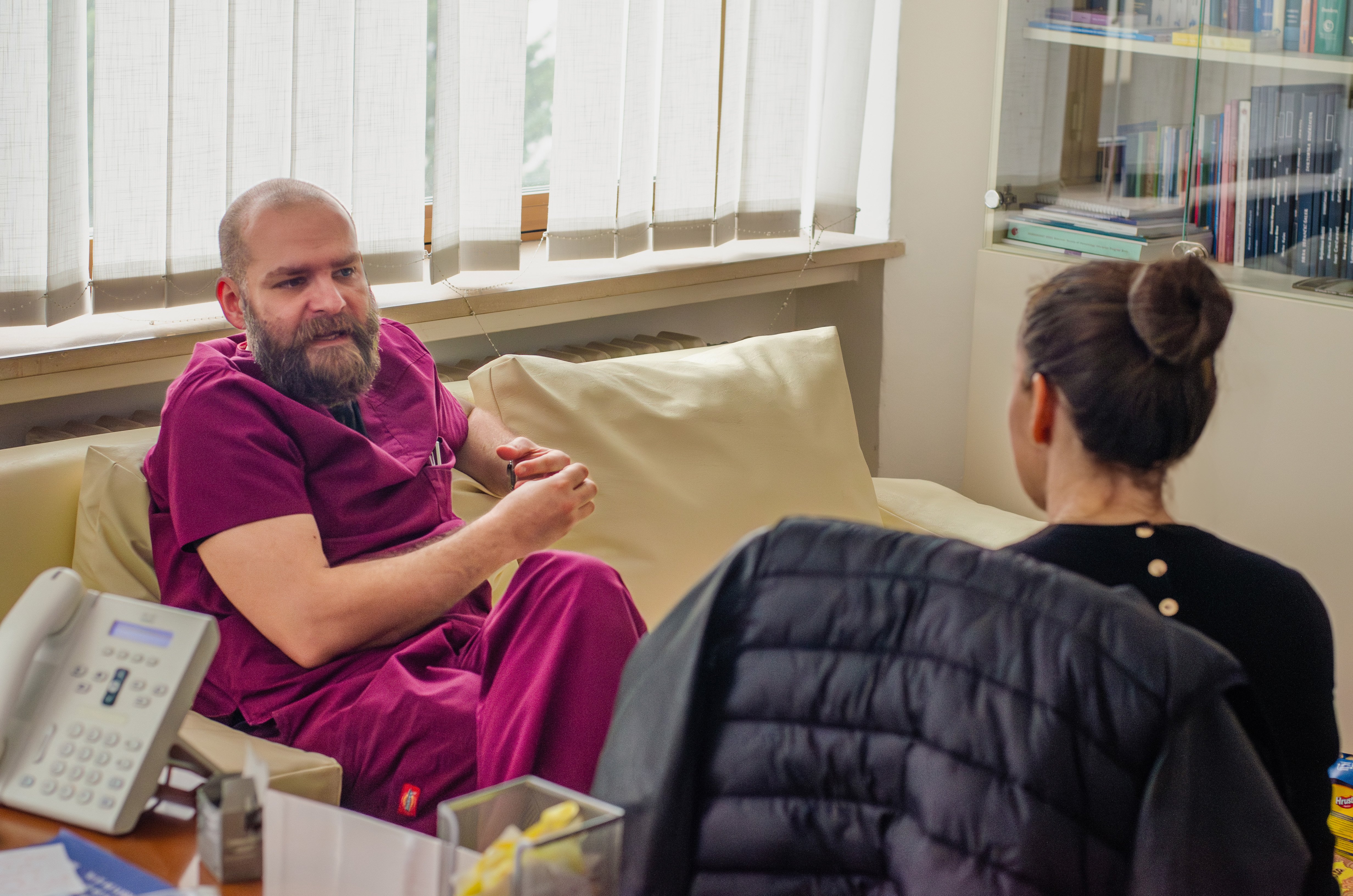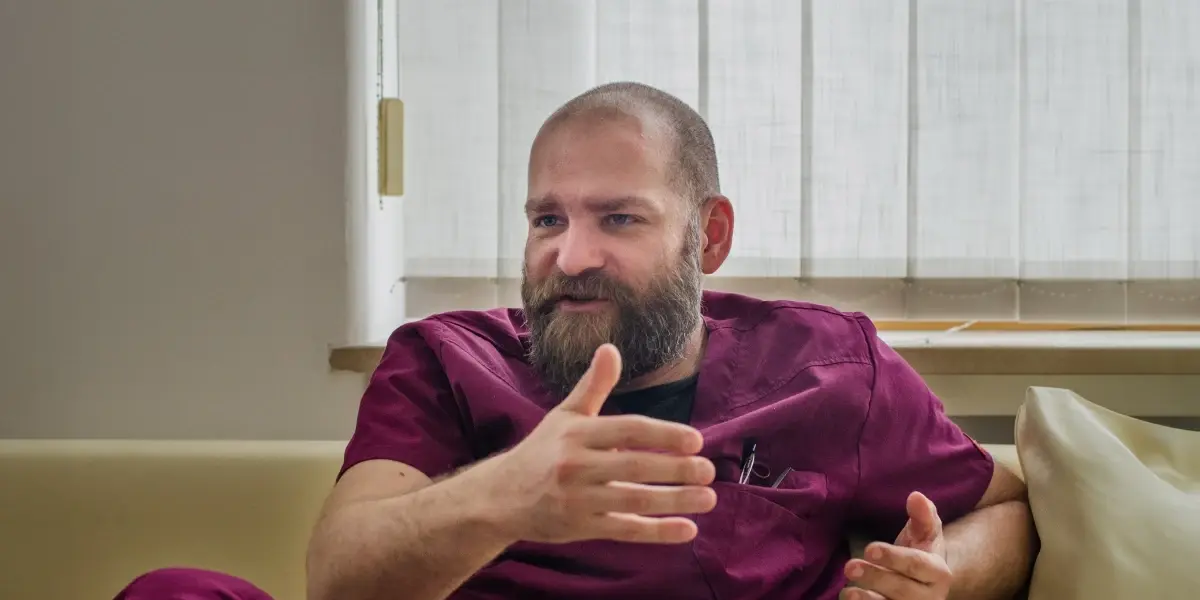Today we have superior possibilities in the treatment of CLL
Dr. sc. Dino Dujmović, a hematologist from the University Hospital Centre (KBC) Zagreb, is a clinician who speaks passionately about his work and specialty. We talked about important topics - treatment options for hematological diseases in Croatia, and especially about his specialty - lymphoproliferative diseases and opportunities for patients and the future of hematology. We also touched on other topics, such as the new digital tools for hematologists in the Mediately application, which provide assistance in clinical practice, in the development of which he himself participated.
In the hematology clinic of KBC Zagreb, you mostly deal with lymphoproliferative diseases. How do patients come to you? What is the path of patients with chronic lymphocytic leukemia and other hematological diseases in the Croatian health system?
Patients develop symptoms and complaints and seek help from family medicine doctors or the emergency department. The findings show that they have a hematological disorder. Depending on the severity of the disease, individuals are referred to the hospital, and patients with slightly elevated lymphocytes and leukocytes are ordered to our clinic. Patients often come to us after systematic examinations or when being treated for other diseases. Although the median age at diagnosis of our patients is 67, we have more and more younger patients.
Each of us at the Zagreb Institute of Hematology has a narrow field of activity. Personally, I am more focused on lymphoproliferative diseases such as lymphomas, chronic lymphocytic leukemia (CLL), multiple myeloma.
Is there progress in the treatment of leukemia, especially CLL?
When I started working in hematology 15 years ago, CLL was somehow a "neglected" disease of old age. However, in the last 5-10 years, significant progress has been made in treatment options. Conventional cytostatic chemotherapy is now used less and less in treatment, and new smart drugs that directly target tumor cells are in practice. Today, CLL is a disease that, with a bit of luck, no longer kills, but instead turns the disease into a chronic condition. The progress is really great; therapies can be used in all forms and combinations, and with them people can have a normal quality of life, carry out normal activities and are disease-free for an average of five to seven years.
When is CLL treated?
CLL is a disease that we don't always need to start treating. A diagnostic examination can be done, but not all invasive diagnostics such as biopsy and CT, and the patient can only be monitored until the moment of meeting clear medical criteria for treatment. An exception is also possible, when the patient does not agree that treatment is not necessary due to the awareness that they have a malignant disease, leukemia. In such cases, we explain everything to the patient, but if they insist on starting treatment, we give them therapy.
We can treat long-term, for life, or we apply the therapy for a year or two, then take a break, and when the disease returns in five or six years, we treat again with targeted therapies. Both approaches have their advantages and disadvantages. In hematology, as well as in the treatment of other proliferative diseases, an individual approach is used in the treatment of each patient. This implies that all possibilities are explained to them and that, taking into account all their characteristics, a joint decision is made with the patient about further treatment. The basic principle is that the therapy does not cause harm, while the next rule is that the therapy is maximally adapted to the patient. Thus, a maximum effect can be achieved with a maximum quality of life.
Diagnosis of CLL can be gradual or according to the principle of "everything immediately". How do hematologists decide on the diagnostic process?
With CLL, we can do all the diagnostics right away and, of course, it is to be expected that some hematologists, perhaps at the beginning of their clinical work, approach it that way. However, it is usually estimated when a patient will need treatment. If we estimate that we will treat the patient in the next three to four weeks, then, of course, we will do all the diagnostics. We have available everything necessary for establishing a diagnosis and determining the stage of the disease in modern hematology. For example, if we have a younger patient who, apart from elevated leukocytes, has no other complaints and we know that we will most likely not start treating them in the next year, it makes no sense to perform a complete invasive diagnosis - cytogenetics, molecular analysis, bone biopsy, PET-CT, CT... because it exposes the patient to discomfort and pressure, and does not give any indication for their therapy. If during monitoring we notice some changes, then we can do tests on them.
When we talk about CLL, do patients in Croatia have access to all medicines?
As for CLL, we can provide all approved therapies. Of course, we have limitations according to the treatment guidelines, but in the first, second and later lines of treatment, we have all medicines available. We can give smart drugs in the first line and in early relapse. We have some limitations with the small population of patients with late relapse of CLL, which is a kind of "gray zone" and the only unmet medical need ("unmet need") in hematology due to CHIF (Croatian Health Insurance Fund) clauses. However, the professional societies are talking to the CHIF and pharmaceutical companies and are trying to help in all ways.
In the treatment of myeloma, we follow the guidelines and have all the drugs that are approved for certain lines of treatment. In the treatment of lymphoma, we have a lot of donation programs for late-line treatments, and there is also CAR-T therapy, which works perfectly.
CAR-T therapy is available to our patients, and we have started to cooperate with neighboring countries that send us their patients. The procedure is very well established. Foreign patients can come for treatment because we have agreements with other countries where the treatment is paid by the insurance company. Since 2020, we have used CAR-T therapy in about 40 patients.
In 2023, we celebrated the 40th anniversary of the first bone marrow transplant at KBC Zagreb. In this field, we are the leading center in this part of Europe and historically among the first in the world to start performing hematopoietic stem cell transplants. We also carry out transplants for foreign patients with a contract between countries or with the patient's own payment. And that program is established, and we are recognized as a center. We are satisfied with our work and results, which are comparable to those of the world.
What is the situation with the treatment of the so-called BTK inhibitors? In which lines do you use them and are you satisfied with the results?
We have available the BTK inhibitors ibrutinib and acalabrutinib in the first and second line of treatment, as well as the BCL2 inhibitor venetoclax and the monoclonal antibodies obinutuzumab and rituximab. We have all the main medicines. As I have already stated, our biggest problem is patients who are in late relapse, that is, who were treated six or seven years ago and now have a return of the disease. We cannot prescribe any of these medications to them.
We have the possibility to give BTK inhibitors of the new generation, we are conducting studies, and we are also looking forward to zanabrutinib, which shows very good results.
We are satisfied with the results of the treatment. The toxicity of BTK inhibitors is slightly higher than in the studies, but this is, of course, because the patients involved in the trials are selected, so the study population differs from that in the real world. In terms of effectiveness, these drugs have been on the market for a long time, and we are satisfied with the results. In the treatment of CLL, today we have the best possibilities.
How many patients can you currently hospitalize at KBC Zagreb?
Under normal conditions, we have 47 hospital beds for hematology, which includes beds for bone marrow transplantation and beds in the department dealing with benign hematology (hemostasis disorders, bleeding, thrombosis, etc.). As for CLL, myeloma and lymphoma, a large proportion of these patients are diagnosed and treated through our day hospital. We are always full ( laughter ).
What is the situation in Croatia regarding the availability of hematologists, especially in the periphery, and not only in the centers?
Most hospitals have a hematologist 24/7, especially large county hospitals. We also have four hematology centers: Split, Osijek, Rijeka, and Zagreb. There are enough hematologists, and they are excellent. Hematologists can be found in every part of Croatia. Patients can get access to therapy not only in most centers, but also in other hospitals because the drugs are not linked to the clinic. However, there are differences in supportive treatment. Larger hospitals have an advantage here. Patients, like elsewhere, gravitate to clinical centers here, but they can also receive therapy closer to their homes. We perform CAR-T and allogeneic transplantation only in KBC Zagreb, while autologous transplantation is performed by KBC Zagreb, KB Dubrava, KB Merkur, and KBC Split.Do you use the Mediately drug database?
I have to admit that I consider myself "old school", that is, I look for information on the Internet and "google" information about medicines. I'm not in the habit of using apps, but I see younger hematologist colleagues who use them a lot and look for information directly, through multiple apps. However, in essence, we can no longer do without smartphones.

You participated in the preparation of the RAI staging tool for our application. How does it serve you and other hematologists?
Honestly, I'm not a very good example of using this tool because staging is in my head since it's part of my daily work routine. I would say that it is "second nature" to me - even if someone woke me up at five in the morning and asked, I could easily classify the disease. However, some functionalities for procedures that I do not perform every day, such as the creatinine clearance calculator or new cardiology scores, are very useful and necessary for me.
I use hematology calculators when I need to calculate and enter data for several patients, for example in trials that may include 50 or more patients.
The amount of knowledge that is required today is really great, so in general, digital tools on smartphones are very helpful. They significantly facilitate work, especially for younger doctors who are still preparing for specialization.
What, in your opinion, could represent the greatest achievement in hematology this year? What are you most looking forward to in the future?
Although we already receive one chimeric antibody for our patients through donations, we are most looking forward to the possibility that in the future, through donations, we could give patients three new bispecific antibodies. This is great for us because we have the opportunity to try the drugs before they become commercially available, and our patients have the opportunity to receive the drug at a stage of the disease when there is nothing else we can offer them. So, this year we could offer a total of four new medicines to our patients, and we are really happy about that. Although the routine is familiar and dear to us, we are ready to try something new and happily look forward to that change.

